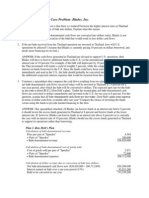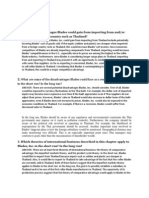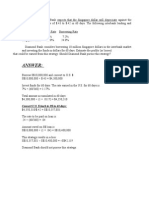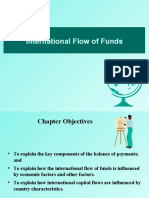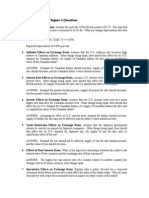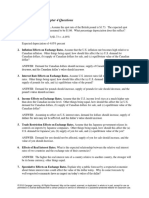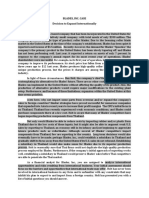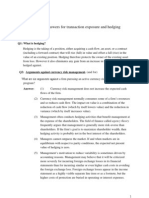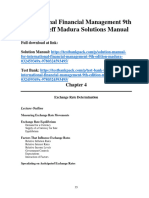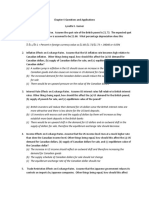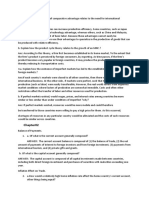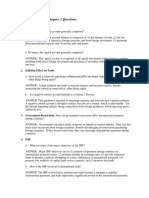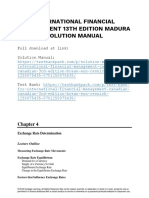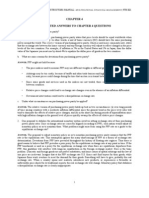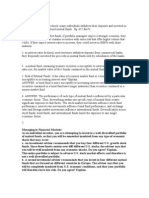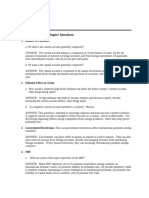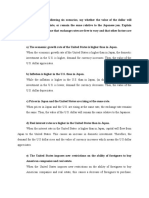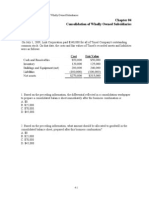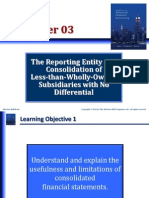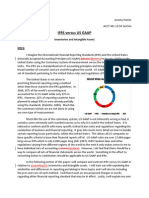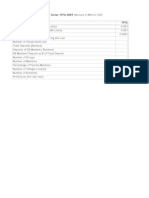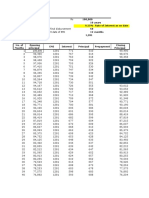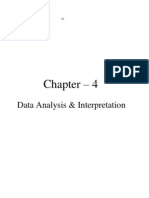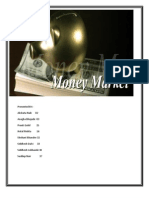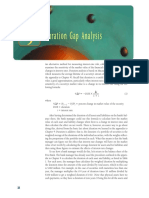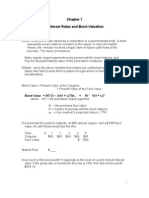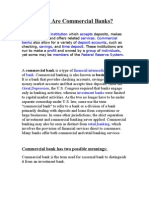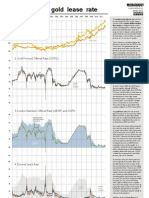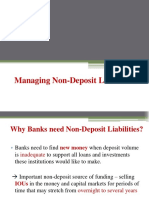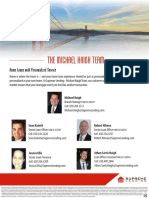100%(5)100% found this document useful (5 votes)
8K viewsCh.4 Answers To End of Chapter Questions
Ch.4 Answers To End of Chapter Questions
Uploaded by
poiriejsThis document contains answers to 15 questions about factors that affect foreign exchange rates. It discusses how variables like interest rates, inflation rates, trade balances, income levels, capital flows, and economic growth in different countries can influence the demand and supply of currencies and cause exchange rates to fluctuate. For example, if a country's interest rates fall relative to another's, demand for its currency may decrease and its value could decline against the other currency. The document examines how these various macroeconomic conditions place pressure on exchange rates in both isolated country examples and in interaction between countries.
Copyright:
© All Rights Reserved
Available Formats
Download as DOCX, PDF, TXT or read online from Scribd
Ch.4 Answers To End of Chapter Questions
Ch.4 Answers To End of Chapter Questions
Uploaded by
poiriejs100%(5)100% found this document useful (5 votes)
8K views9 pagesThis document contains answers to 15 questions about factors that affect foreign exchange rates. It discusses how variables like interest rates, inflation rates, trade balances, income levels, capital flows, and economic growth in different countries can influence the demand and supply of currencies and cause exchange rates to fluctuate. For example, if a country's interest rates fall relative to another's, demand for its currency may decrease and its value could decline against the other currency. The document examines how these various macroeconomic conditions place pressure on exchange rates in both isolated country examples and in interaction between countries.
Original Description:
INternational Financial Management Ch 4 Solutions
Original Title
Ch 4
Copyright
© © All Rights Reserved
Available Formats
DOCX, PDF, TXT or read online from Scribd
Share this document
Did you find this document useful?
Is this content inappropriate?
This document contains answers to 15 questions about factors that affect foreign exchange rates. It discusses how variables like interest rates, inflation rates, trade balances, income levels, capital flows, and economic growth in different countries can influence the demand and supply of currencies and cause exchange rates to fluctuate. For example, if a country's interest rates fall relative to another's, demand for its currency may decrease and its value could decline against the other currency. The document examines how these various macroeconomic conditions place pressure on exchange rates in both isolated country examples and in interaction between countries.
Copyright:
© All Rights Reserved
Available Formats
Download as DOCX, PDF, TXT or read online from Scribd
Download as docx, pdf, or txt
100%(5)100% found this document useful (5 votes)
8K views9 pagesCh.4 Answers To End of Chapter Questions
Ch.4 Answers To End of Chapter Questions
Uploaded by
poiriejsThis document contains answers to 15 questions about factors that affect foreign exchange rates. It discusses how variables like interest rates, inflation rates, trade balances, income levels, capital flows, and economic growth in different countries can influence the demand and supply of currencies and cause exchange rates to fluctuate. For example, if a country's interest rates fall relative to another's, demand for its currency may decrease and its value could decline against the other currency. The document examines how these various macroeconomic conditions place pressure on exchange rates in both isolated country examples and in interaction between countries.
Copyright:
© All Rights Reserved
Available Formats
Download as DOCX, PDF, TXT or read online from Scribd
Download as docx, pdf, or txt
You are on page 1of 9
At a glance
Powered by AI
The document discusses factors that affect exchange rates such as inflation, interest rates, trade flows, capital flows, and government policies.
Factors that can affect exchange rates include inflation rates, interest rates, trade balances, capital flows, government policies such as taxes and regulations.
Generally, higher inflation puts downward pressure on a currency as imports become more expensive, while higher interest rates can attract capital inflows and support a currency. Inflation has a stronger effect when trade flows are significant and capital flows are negligible.
The following is from: International Financial Management, 10e.
, by Jeff Madura, ISBN 978-0-324-
56819-6. Specifically taken from the Instructor's Manual, End of Chapter Questions & Answers
Ch.4 Answers to End of Chapter Questions
1. Percentage Depreciation. Assume the spot rate of the British pound is $1.73. The expected spot rate
one year from now is assumed to be $1.66. What percentage depreciation does this reflect?
ANSWER: ($1.66 $1.73)/$1.73 = 4.05%
Expected depreciation of 4.05% percent
2. Inflation Effects on Exchange Rates. Assume that the U.S. inflation rate becomes high relative to
Canadian inflation. Other things being equal, how should this affect the (a) U.S. demand for Canadian
dollars, (b) supply of Canadian dollars for sale, and (c) equilibrium value of the Canadian dollar?
ANSWER: Demand for Canadian dollars should increase, supply of Canadian dollars for sale should
decrease, and the Canadian dollars value should increase.
3. Interest Rate Effects on Exchange Rates. Assume U.S. interest rates fall relative to British interest
rates. Other things being equal, how should this affect the (a) U.S. demand for British pounds, (b)
supply of pounds for sale, and (c) equilibrium value of the pound?
ANSWER: Demand for pounds should increase, supply of pounds for sale should decrease, and the
pounds value should increase.
4. Income Effects on Exchange Rates. Assume that the U.S. income level rises at a much higher rate
than does the Canadian income level. Other things being equal, how should this affect the (a) U.S.
demand for Canadian dollars, (b) supply of Canadian dollars for sale, and (c) equilibrium value of the
Canadian dollar?
ANSWER: Assuming no effect on U.S. interest rates, demand for dollars should increase, supply of
dollars for sale may not be affected, and the dollars value should increase.
5. Trade Restriction Effects on Exchange Rates. Assume that the Japanese government relaxes its
controls on imports by Japanese companies. Other things being equal, how should this affect the (a)
U.S. demand for Japanese yen, (b) supply of yen for sale, and (c) equilibrium value of the yen?
ANSWER: Demand for yen should not be affected, supply of yen for sale should increase, and the
value of yen should decrease.
6. Effects of Real Interest Rates. What is the expected relationship between the relative real interest
rates of two countries and the exchange rate of their currencies?
ANSWER: The higher the real interest rate of a country relative to another country, the stronger will
be its home currency, other things equal.
7. Speculative Effects on Exchange Rates. Explain why a public forecast by a respected economist
about future interest rates could affect the value of the dollar today. Why do some forecasts by
well-respected economists have no impact on todays value of the dollar?
ANSWER: Interest rate movements affect exchange rates. Speculators can use anticipated interest
rate movements to forecast exchange rate movements. They may decide to purchase securities in
The following is from: International Financial Management, 10e., by Jeff Madura, ISBN 978-0-324-
56819-6. Specifically taken from the Instructor's Manual, End of Chapter Questions & Answers
particular countries because of their expectations about currency movements, since their yield will be
affected by changes in a currencys value. These purchases of securities require an exchange of
currencies, which can immediately affect the equilibrium value of exchange rates.
If a forecast of interest rates by a respected economist was already anticipated by market participants
or is not different from investors original expectations, an announced forecast does not provide new
information. Thus, there would be no reaction by investors to such an announcement, and exchange
rates would not be affected.
8. Factors Affecting Exchange Rates. What factors affect the future movements in the value of the
euro against the dollar?
ANSWER: The euros value could change because of the balance of trade, which reflects more U.S.
demand for European goods than the European demand for U.S. goods. The capital flows between the
U.S. and Europe will also affect the U.S. demand for euros and the supply of euros for sale (to be
exchanged for dollars).
9. Interaction of Exchange Rates. Assume that there are substantial capital flows among Canada, the
U.S., and Japan. If interest rates in Canada decline to a level below the U.S. interest rate, and
inflationary expectations remain unchanged, how could this affect the value of the Canadian dollar
against the U.S. dollar? How might this decline in Canadas interest rates possibly affect the value of
the Canadian dollar against the Japanese yen?
ANSWER: If interest rates in Canada decline, there may be an increase in capital flows from Canada
to the U.S. In addition, U.S. investors may attempt to capitalize on higher U.S. interest rates, while
U.S. investors reduce their investments in Canadas securities. This places downward pressure on the
Canadian dollars value.
Japanese investors that previously invested in Canada may shift to the U.S. Thus, the reduced flow of
funds from Japan would place downward pressure on the Canadian dollar against the Japanese yen.
10. Trade Deficit Effects on Exchange Rates. Every month, the U.S. trade deficit figures are
announced. Foreign exchange traders often react to this announcement and even attempt to forecast
the figures before they are announced.
a. Why do you think the trade deficit announcement sometimes has such an impact on foreign
exchange trading?
ANSWER: The trade deficit announcement may provide a reasonable forecast of future trade deficits
and therefore has implications about supply and demand conditions in the foreign exchange market.
For example, if the trade deficit was larger than anticipated, and is expected to continue, this implies
that the U.S. demand for foreign currencies may be larger than initially anticipated. Thus, the dollar
would be expected to weaken. Some speculators may take a position in foreign currencies
immediately and could cause an immediate decline in the dollar.
b. In some periods, foreign exchange traders do not respond to a trade deficit announcement, even
when the announced deficit is very large. Offer an explanation for such a lack of response.
ANSWER: If the market correctly anticipated the trade deficit figure, then any news contained in the
announcement has already been accounted for in the market. The market should only respond to an
announcement about the trade deficit if the announcement contains new information.
The following is from: International Financial Management, 10e., by Jeff Madura, ISBN 978-0-324-
56819-6. Specifically taken from the Instructor's Manual, End of Chapter Questions & Answers
11. Comovements of Exchange Rates. Explain why the value of the British pound against the dollar will
not always move in tandem with the value of the euro against the dollar.
ANSWER: The euros value changes in response to the flow of funds between the U.S. and the
countries using the euro or their currency. The pounds value changes in response to the flow of funds
between the U.S. and the U.K. [Answer is based on intuition, is not directly from the text.]
12. Factors Affecting Exchange Rates. In the 1990s, Russia was attempting to import more goods but
had little to offer other countries in terms of potential exports. In addition, Russias inflation rate was
high. Explain the type of pressure that these factors placed on the Russian currency.
ANSWER: The large amount of Russian imports and lack of Russian exports placed downward
pressure on the Russian currency. The high inflation rate in Russia also placed downward pressure on
the Russian currency.
13. National Income Effects. Analysts commonly attribute the appreciation of a currency to expectations
that economic conditions will strengthen. Yet, this chapter suggests that when other factors are held
constant, increased national income could increase imports and cause the local currency to weaken. In
reality, other factors are not constant. What other factor is likely to be affected by increased economic
growth and could place upward pressure on the value of the local currency?
ANSWER: Interest rates tend to rise in response to a stronger economy, and higher interest rates can
place upward pressure on the local currency (as long as there is not offsetting pressure by higher
expected inflation).
14. Factors Affecting Exchange Rates. If the Asian countries experience a decline in economic growth
(and experience a decline in inflation and interest rates as a result), how will their currency values
(relative to the U.S. dollar) be affected?
ANSWER: A relative decline in Asian economic growth will reduce Asian demand for U.S. products,
which places upward pressure on Asian currencies. However, given the change in interest rates, Asian
corporations with excess cash may now invest in the U.S. or other countries, thereby increasing the
demand for U.S. dollars. Thus, a decline in Asian interest rates will place downward pressure on the
value of the Asian currencies. The overall impact depends on the magnitude of the forces just
described.
15. Impact of Crises. Why do you think most crises in countries (such as the Asian crisis) cause the local
currency to weaken abruptly? Is it because of trade or capital flows?
ANSWER: Capital flows have a larger influence. In general, crises tend to cause investors to expect
that there will be less investment in the country in the future and also cause concern that any existing
investments will generate poor returns (because of defaults on loans or reduced valuations of stocks).
Thus, as investors liquidate their investments and convert the local currency into other currencies to
invest elsewhere, downward pressure is placed on the local currency.
16. Impact of September 11. The terrorist attacks on the U.S. on September 11, 2001 were expected to
weaken U.S. economic conditions, and reduce U.S. interest rates. How do you think the weaker U.S.
economic conditions would affect trade flows? How would this have affected the value of the dollar
(holding other factors constant)? How do you think the lower U.S. interest rates would have affected
the value of the U.S. dollar (holding other factors constant)?
The following is from: International Financial Management, 10e., by Jeff Madura, ISBN 978-0-324-
56819-6. Specifically taken from the Instructor's Manual, End of Chapter Questions & Answers
ANSWER: The weak U.S. economy would result in a reduced demand for foreign products, which
results in a decline in the demand for foreign currencies, and therefore places downward pressure on
currencies relative to the dollar (upward pressure on the dollars value). The lower U.S. interest rates
should reduce the capital flows to the U.S., which place downward pressure on the value of the dollar.
Advanced Questions
17. Measuring Effects on Exchange Rates. Tarheel Co. plans to determine how changes in U.S. and
Mexican real interest rates will affect the value of the U.S. dollar. (See Appendix C.)
a. Describe a regression model that could be used to achieve this purpose. Also explain the expected
sign of the regression coefficient.
ANSWER: Various models are possible. One model would be:
% Change = a
0
+ a
1
(r
U.S.
r
M
) + u
in peso
Where
r
U.S.
= real interest rate in the U.S.
r
M
= real interest rate in Mexico
a
0
= intercept
a
1
= regression coefficient measuring the relationship between the real interest
rate differential and the percentage change in the pesos value
u = error term
Based on the model above, the regression coefficient is expected to have a negative sign. A relatively
high real interest rate differential would likely cause a weaker peso value, other things being equal.
An appropriate model would also include other independent variables that may influence the
percentage change in the pesos value.
b. If Tarheel Co. thinks that the existence of a quota in particular historical periods may have
affected exchange rates, how might this be accounted for in the regression model?
ANSWER: A dummy variable could be included in the model, assigned a value of one for periods
when a quota existed and a value of zero when it did not exist. This answer requires some creative
thinking, as it is not drawn directly from the text.
18. Factors Affecting Exchange Rates. Mexico tends to have much higher inflation than the United
States and also much higher interest rates than the United States. Inflation and interest rates are much
more volatile in Mexico than in industrialized countries. The value of the Mexican peso is typically
The following is from: International Financial Management, 10e., by Jeff Madura, ISBN 978-0-324-
56819-6. Specifically taken from the Instructor's Manual, End of Chapter Questions & Answers
more volatile than the currencies of industrialized countries from a U.S. perspective; it has typically
depreciated from one year to the next, but the degree of depreciation has varied substantially. The
bid/ask spread tends to be wider for the peso than for currencies of industrialized countries.
a. Identify the most obvious economic reason for the persistent depreciation of the peso.
ANSWER: The high inflation in Mexico places continual downward pressure on the value of the
peso.
b. High interest rates are commonly expected to strengthen a countrys currency because they can
encourage foreign investment in securities in that country, which results in the exchange of other
currencies for that currency. Yet, the pesos value has declined against the dollar over most years
even though Mexican interest rates are typically much higher than U.S. interest rates. Thus, it
appears that the high Mexican interest rates do not attract substantial U.S. investment in Mexicos
securities. Why do you think U.S. investors do not try to capitalize on the high interest rates in
Mexico?
ANSWER: The high interest rates in Mexico result from expectations of high inflation. That is, the
real interest rate in Mexico may not be any higher than the U.S. real interest rate. Given the high
inflationary expectations, U.S. investors recognize the potential weakness of the peso, which could
more than offset the high interest rate (when they convert the pesos back to dollars at the end of the
investment period). Therefore, the high Mexican interest rates do not encourage U.S. investment in
Mexican securities, and do not help to strengthen the value of the peso.
c. Why do you think the bid/ask spread is higher for pesos than for currencies of industrialized
countries? How does this affect a U.S. firm that does substantial business in Mexico?
ANSWER: The bid/ask spread is wider because the banks that provide foreign exchange services are
subject to more risk when they maintain currencies such as the peso that could decline abruptly at any
time. A wider bid/ask spread adversely affects the U.S. firm that does business in Mexico because it
increases the transactions costs associated with conversion of dollars to pesos, or pesos to dollars.
19. Aggregate Effects on Exchange Rates. Assume that the United States invests heavily in government
and corporate securities of Country K. In addition, residents of Country K invest heavily in the United
States. Approximately $10 billion worth of investment transactions occur between these two countries
each year. The total dollar value of trade transactions per year is about $8 million. This information is
expected to also hold in the future.
Because your firm exports goods to Country K, your job as international cash manager requires you
to forecast the value of Country Ks currency (the krank) with respect to the dollar. Explain how
each of the following conditions will affect the value of the krank, holding other things equal. Then,
aggregate all of these impacts to develop an overall forecast of the kranks movement against the
dollar.
a. U.S. inflation has suddenly increased substantially, while Country Ks inflation remains low.
ANSWER: Increased U.S. demand for the krank. Decreased supply of kranks for sale. Upward
pressure in the kranks value.
b. U.S. interest rates have increased substantially, while Country Ks interest rates remain low.
Investors of both countries are attracted to high interest rates.
The following is from: International Financial Management, 10e., by Jeff Madura, ISBN 978-0-324-
56819-6. Specifically taken from the Instructor's Manual, End of Chapter Questions & Answers
ANSWER: Decreased U.S. demand for the krank. Increased supply of kranks for sale. Downward
pressure on the kranks value.
c. The U.S. income level increased substantially, while Country Ks income level has remained
unchanged.
ANSWER: Increased U.S. demand for the krank. Upward pressure on the kranks value.
d. The U.S. is expected to impose a small tariff on goods imported from Country K.
ANSWER: The tariff will cause a decrease in the United States desire for Country Ks goods, and
will therefore reduce the demand for kranks for sale. Downward pressure on the kranks value.
e. Combine all expected impacts to develop an overall forecast.
ANSWER: Two of the scenarios described above place upward pressure on the value of the krank.
However, these scenarios are related to trade, and trade flows are relatively minor between the U.S.
and Country K. The interest rate scenario places downward pressure on the kranks value. Since the
interest rates affect capital flows and capital flows dominate trade flows between the U.S. and
Country K, the interest rate scenario should overwhelm all other scenarios. Thus, when considering
the importance of implications of all scenarios, the krank is expected to depreciate.
20. Speculation. Blue Demon Bank expects that the Mexican peso will depreciate against the dollar from
its spot rate of $.15 to $.14 in 10 days. The following interbank lending and borrowing rates exist:
Lending Rate Borrowing Rate
U.S. dollar 8.0% 8.3%
Mexican peso 8.5% 8.7%
Assume that Blue Demon Bank has a borrowing capacity of either $10 million or 70 million pesos in
the interbank market, depending on which currency it wants to borrow.
a. How could Blue Demon Bank attempt to capitalize on its expectations without using deposited
funds? Estimate the profits that could be generated from this strategy.
ANSWER: Blue Demon Bank can capitalize on its expectations about pesos (MXP) as follows:
1. Borrow MXP70 million
2. Convert the MXP70 million to dollars:
MXP70,000,000 $.15 = $10,500,000
3. Lend the dollars through the interbank market at 8.0% annualized over a 10-day period. The
amount accumulated in 10 days is:
$10,500,000 [1 + (8% 10/360)] = $10,500,000 [1.002222] = $10,523,333
4. Repay the peso loan. The repayment amount on the peso loan is:
The following is from: International Financial Management, 10e., by Jeff Madura, ISBN 978-0-324-
56819-6. Specifically taken from the Instructor's Manual, End of Chapter Questions & Answers
MXP70,000,000 [1 + (8.7% 10/360)] = 70,000,000 [1.002417]=MXP70,169,167
5. Based on the expected spot rate of $.14, the amount of dollars needed to repay the peso loan is:
MXP70,169,167 $.14 = $9,823,683
6. After repaying the loan, Blue Demon Bank will have a speculative profit (if its forecasted
exchange rate is accurate) of:
$10,523,333 $9,823,683 = $699,650
b. Assume all the preceding information with this exception: Blue Demon Bank expects the peso to
appreciate from its present spot rate of $.15 to $.17 in 30 days. How could it attempt to capitalize
on its expectations without using deposited funds? Estimate the profits that could be generated
from this strategy.
ANSWER: Blue Demon Bank can capitalize on its expectations as follows:
1. Borrow $10 million
2. Convert the $10 million to pesos (MXP):
$10,000,000/$.15 = MXP66,666,667
3. Lend the pesos through the interbank market at 8.5% annualized over a 30-day period. The
amount accumulated in 30 days is:
MXP66,666,667 [1 + (8.5% 30/360)] = 66,666,667 [1.007083] = MXP67,138,889
4. Repay the dollar loan. The repayment amount on the dollar loan is:
$10,000,000 [1 + (8.3% 30/360)] = $10,000,000 [1.006917] = $10,069,170
5. Convert the pesos to dollars to repay the loan. The amount of dollars to be received in 30 days
(based on the expected spot rate of $.17) is:
MXP67,138,889 $.17 = $11,413,611
6. The profits are determined by estimating the dollars available after repaying the loan:
$11,413,611 $10,069,170 = $1,344,441
21. Speculation. Diamond Bank expects that the Singapore dollar will depreciate against the dollar from
its spot rate of $.43 to $.42 in 60 days. The following interbank lending and borrowing rates exist:
Lending Rate Borrowing Rate
U.S. dollar 7.0% 7.2%
Singapore dollar 22.0% 24.0%
The following is from: International Financial Management, 10e., by Jeff Madura, ISBN 978-0-324-
56819-6. Specifically taken from the Instructor's Manual, End of Chapter Questions & Answers
Diamond Bank considers borrowing 10 million Singapore dollars in the interbank market and
investing the funds in dollars for 60 days. Estimate the profits (or losses) that could be earned from
this strategy. Should Diamond Bank pursue this strategy?
ANSWER:
Borrow S$10,000,000 and convert to U.S. $:
S$10,000,000 $.43 = $4,300,000
Invest funds for 60 days. The rate earned in the U.S. for 60 days is:
7% (60/360) = 1.17%
Total amount accumulated in 60 days:
$4,300,000 (1 + .0117) = $4,350,310
Convert U.S. $ back to S$ in 60 days:
$4,350,310/$.42 = S$10,357,881
The rate to be paid on loan is:
.24 (60/360) = .04
Amount owed on S$ loan is:
S$10,000,000 (1 + .04) = S$10,400,000
This strategy results in a loss:
S$10,357,881 S$10,400,000 = S$42,119
Diamond Bank should not pursue this strategy.
22. Relative Importance of Factors Affecting Exchange Rate Risk. Assume that the level of capital
flows between the U.S. and the country of Krendo is negligible (close to zero) and will continue to be
negligible. There is a substantial amount of trade between the U.S. and the country of Krendo and no
capital flows. How will high inflation and high interest rates affect the value of the kren (Krendos
currency)? Explain.
ANSWER: The inflation effect will be stronger than the interest rate effect because inflation affects
trade flows. The high inflation should cause downward pressure on the kren.
23. Assessing the Euros Potential Movements. You reside in the U.S. and are planning to make a one-
year investment in Germany during the next year. Since the investment is denominated in euros, you
want to forecast how the euros value may change against the dollar over the one-year period. You
expect that Germany will experience an inflation rate of 1% during the next year, while all other
European countries will experience an inflation rate of 8% over the next year. You expect that the
U.S. will experience an annual inflation rate of 2% during the next year. You believe that the primary
factor that affects any exchange rate is the inflation rate. Based on the information provided in this
question, will the euro appreciate, depreciate, or stay at about the same level against the dollar over
the next year? Explain.
ANSWER: The euro should depreciate because most countries in the Eurozone are presumed to have
high inflation.
The following is from: International Financial Management, 10e., by Jeff Madura, ISBN 978-0-324-
56819-6. Specifically taken from the Instructor's Manual, End of Chapter Questions & Answers
24. Weighing Factors That Affect Exchange Rates. Assume that the level of capital flows between the
U.S. and the country of Zeus is negligible (close to zero) and will continue to be negligible. There is a
substantial amount of trade between the U.S. and the country of Zeus. The main import by the U.S. is
basic clothing purchased by U.S. retail stores from Zeus, while the main import by Zeus is special
computer chips that are only made in the U.S. and are needed by many manufacturers in Zeus.
Suddenly, the U.S. government decides to impose a 20% tax on the clothing imports. The Zeus
government immediately retaliates by imposing a 20% tax on the computer chip imports. Second, the
Zeus government immediately imposes a 60% tax on any interest income that would be earned by
Zeus investors if they buy U.S. securities. Third, the Zeus central bank raises its local interest rates so
that they are now higher than interest rates in the U.S. Do you think the currency of Zeus (called the
zee) will appreciate or depreciate against the dollar as a result of all the government actions described
above? Explain.
ANSWER: The zee should depreciate, because Zeus imports of U.S. computer chips will continue, while
the U.S. imports of Zeus clothing will decrease. The Zeus tax on capital flows and the central bank
actions will not have an effect because the Zeus investors do not buy U.S. securities anyway.
You might also like
- International Financial Management 9th Edition Jeff Madura Solutions Manual 1Document15 pagesInternational Financial Management 9th Edition Jeff Madura Solutions Manual 1eleanor100% (57)
- Test Bank For International Financial Management 8th Edition by EunDocument37 pagesTest Bank For International Financial Management 8th Edition by EunNgô Lan Tường100% (2)
- Blades, Inc. CaseDocument2 pagesBlades, Inc. CaseSam Chau90% (10)
- International Financial Management Chapter 9 Case StudyDocument4 pagesInternational Financial Management Chapter 9 Case Studypizzachicagostyle2711100% (2)
- Madura Chapter 8Document9 pagesMadura Chapter 8MasiNo ratings yet
- Blade Inc Chapter 7Document5 pagesBlade Inc Chapter 7Zahid Rizvy100% (2)
- Madura Chapter 6 PDFDocument13 pagesMadura Chapter 6 PDFRizaldy Aji MuzakkyNo ratings yet
- Imf Quiz 1 - MaduraDocument4 pagesImf Quiz 1 - MaduraTheSupaDupa100% (3)
- Blades PLC Case StudyDocument7 pagesBlades PLC Case StudyMohd Farid100% (1)
- Chapter 10 SolutionsDocument8 pagesChapter 10 Solutionsalice123h2150% (2)
- CHP 4 5 CasesDocument8 pagesCHP 4 5 Casesnabilredascribd50% (2)
- Blade Inc CaseDocument11 pagesBlade Inc Caserasha_fayez60% (5)
- Managerial AccountingDocument3 pagesManagerial AccountingEmad Rashid100% (1)
- Assignment #2 Exchange Rate BehaviorDocument7 pagesAssignment #2 Exchange Rate BehaviorjosephblinkNo ratings yet
- Solution: International Inance SsignmentDocument7 pagesSolution: International Inance SsignmentJamshidNo ratings yet
- A Presentation On "Blades Inc. Case (Direct Foreign Investment) "Document10 pagesA Presentation On "Blades Inc. Case (Direct Foreign Investment) "devrajkinjal100% (2)
- Chapter 2 International Flow of Funds by Jeff MaduraDocument23 pagesChapter 2 International Flow of Funds by Jeff MaduraNazmul H. Palash100% (1)
- Investments Analysis and Management 12th Edition Charles P Jones Test BankDocument10 pagesInvestments Analysis and Management 12th Edition Charles P Jones Test BankMohmed GodaNo ratings yet
- Blades IFMDocument2 pagesBlades IFMtikanath100% (2)
- ACCT Ch. 19 Test BankDocument47 pagesACCT Ch. 19 Test BankThe Lotus Eater67% (6)
- Interest Rate Swap IllustrationDocument15 pagesInterest Rate Swap IllustrationVaidyanathan RavichandranNo ratings yet
- Chenoa Fund Training #2 - For UnderwritersDocument35 pagesChenoa Fund Training #2 - For UnderwriterschenoaNo ratings yet
- Loan Agreement Template 03Document2 pagesLoan Agreement Template 03Yusuf Wahid100% (1)
- Chapter 4 - Exchange Rate DeterminationDocument9 pagesChapter 4 - Exchange Rate Determinationhy_saingheng_760260980% (10)
- Answers To End of Chapter Questions: Chapter 3: International Financial MarketsDocument5 pagesAnswers To End of Chapter Questions: Chapter 3: International Financial MarketsNgan Nguyen100% (1)
- International Corporate Finance Solution ManualDocument44 pagesInternational Corporate Finance Solution ManualMarshal Richard91% (35)
- Madura IFM10e IM Ch04Document11 pagesMadura IFM10e IM Ch04waqar hattarNo ratings yet
- Chapter 7Document9 pagesChapter 7Kc Saw100% (4)
- Chapter 15 HW SolutionDocument5 pagesChapter 15 HW SolutionZarifah FasihahNo ratings yet
- Exchange Rate Determination: SOLUTION: ($0.73 - $0.69) /$0.69 5.80%Document11 pagesExchange Rate Determination: SOLUTION: ($0.73 - $0.69) /$0.69 5.80%rufik der100% (2)
- Blades Inc Case of IFMDocument3 pagesBlades Inc Case of IFMimaal86% (7)
- Blades Inc. Case, Assessment of Risk Exposure, (Jeff Madura, International Financial Management)Document8 pagesBlades Inc. Case, Assessment of Risk Exposure, (Jeff Madura, International Financial Management)raihans_dhk337894% (18)
- Madura ch4 TBDocument11 pagesMadura ch4 TBSameh Ahmed Hassan80% (5)
- MCQ Chap 4Document6 pagesMCQ Chap 4Diệu QuỳnhNo ratings yet
- Chapter 1 3Document17 pagesChapter 1 3Hieu Duong Trong100% (3)
- Blades, Inc. Case Decision To Expand InternationallyDocument8 pagesBlades, Inc. Case Decision To Expand InternationallyUniversitas KadiriNo ratings yet
- Shapiro Chapter 14 Solutions PDFDocument11 pagesShapiro Chapter 14 Solutions PDFyuliNo ratings yet
- Chapter 6 Government Influence On Exchange Rates QuizDocument7 pagesChapter 6 Government Influence On Exchange Rates Quizhy_saingheng_7602609100% (4)
- IFM TB Ch08Document9 pagesIFM TB Ch08isgodNo ratings yet
- BladesDocument19 pagesBladescristianofoni100% (1)
- International Financial Management 5Document53 pagesInternational Financial Management 5胡依然100% (1)
- Questions and Answers For Transaction Exposure and HedgingDocument8 pagesQuestions and Answers For Transaction Exposure and HedgingvanvunNo ratings yet
- Blades Inc CaseDocument3 pagesBlades Inc Casemasskillz33% (3)
- IFM TB ch16Document9 pagesIFM TB ch16Faizan Ch100% (1)
- BladesDocument1 pageBladesWulandari Pramithasari50% (2)
- Blade Inc Case Assessment Government On Exchange RateDocument7 pagesBlade Inc Case Assessment Government On Exchange RateNguyễn Linh TrangNo ratings yet
- Case StudyDocument4 pagesCase StudyFaizan Ch0% (1)
- Chapter 4 Exchange Rate DeterminationDocument5 pagesChapter 4 Exchange Rate DeterminationAsterina AnggrainiNo ratings yet
- Exchange Rate Determination: Answers To End of Chapter QuestionsDocument14 pagesExchange Rate Determination: Answers To End of Chapter QuestionsMichael Rongo0% (1)
- International Financial Management 9th Edition Jeff Madura Solutions Manual 1Document36 pagesInternational Financial Management 9th Edition Jeff Madura Solutions Manual 1paulagomezcjsqfeaoyi100% (45)
- Solution CH 4Document14 pagesSolution CH 4Isnaeni PratiwiNo ratings yet
- Ch4-INTFINCQUESTIONS AND ANSWERSDocument3 pagesCh4-INTFINCQUESTIONS AND ANSWERSlynette_garner_1No ratings yet
- Lecture Outline: Exchange Rate DeterminationDocument17 pagesLecture Outline: Exchange Rate DeterminationPaul DidzbanisNo ratings yet
- International Financial Management Not Examined Mid-Term QuestionsDocument6 pagesInternational Financial Management Not Examined Mid-Term QuestionsQadar ChannelNo ratings yet
- Chapter 2Document4 pagesChapter 2Muhammad ImranNo ratings yet
- International Financial Management 13th Edition Madura Solutions Manual 1Document27 pagesInternational Financial Management 13th Edition Madura Solutions Manual 1keithreynoldsrciaejxmqf100% (41)
- International Financial Management 13th Edition Madura Solutions Manual 1Document19 pagesInternational Financial Management 13th Edition Madura Solutions Manual 1eleanor100% (66)
- Solutions Chapter 4 Parity ConditionsDocument15 pagesSolutions Chapter 4 Parity ConditionsKenny ZhouNo ratings yet
- NullDocument22 pagesNullapi-28191758100% (1)
- TUTORIAL 6 SOLUTION GUIDE (From Chapter 8) Q4Document5 pagesTUTORIAL 6 SOLUTION GUIDE (From Chapter 8) Q4hien05No ratings yet
- International Corporate Finance Solution ManualDocument44 pagesInternational Corporate Finance Solution ManualPetraNo ratings yet
- It'll Finance: Dr. Mohammad Magableh Section 101 Bader Al-Hamed ID: 200901007 Assignment: Ch. 2 Problems SolutionDocument7 pagesIt'll Finance: Dr. Mohammad Magableh Section 101 Bader Al-Hamed ID: 200901007 Assignment: Ch. 2 Problems SolutionfahadNo ratings yet
- Ch2Solutions12thed 1Document5 pagesCh2Solutions12thed 1zphamcamdaoNo ratings yet
- Final Sample Econ 141Document2 pagesFinal Sample Econ 141Elliot NounouNo ratings yet
- If Tut 4Document7 pagesIf Tut 4Ong CHNo ratings yet
- CH 07 Long Lived Assets Should Not Be Accrued in The Governemnatl FundsDocument1 pageCH 07 Long Lived Assets Should Not Be Accrued in The Governemnatl FundspoiriejsNo ratings yet
- 3500 Miles 736.05 $ Hotel TotalsDocument2 pages3500 Miles 736.05 $ Hotel TotalspoiriejsNo ratings yet
- Chap004 Consolidation of Wholly Owned SubsidiariesDocument56 pagesChap004 Consolidation of Wholly Owned SubsidiariespoiriejsNo ratings yet
- BE20-1, BE20-2, E20-1 (A), E20-2Document1 pageBE20-1, BE20-2, E20-1 (A), E20-2poiriejsNo ratings yet
- Culture and Leadership in Implementing StrategyDocument13 pagesCulture and Leadership in Implementing StrategypoiriejsNo ratings yet
- Chap 003Document76 pagesChap 003poiriejsNo ratings yet
- Chap004 Consolidation of Wholly Owned SubsidiariesDocument56 pagesChap004 Consolidation of Wholly Owned SubsidiariespoiriejsNo ratings yet
- IFRS Vs GAAP PaperDocument8 pagesIFRS Vs GAAP PaperpoiriejsNo ratings yet
- REG NINJA Study PlannerDocument3 pagesREG NINJA Study PlannerpoiriejsNo ratings yet
- Chap 004Document66 pagesChap 004poiriejsNo ratings yet
- Hull OFOD10e MultipleChoice Questions Only Ch04Document4 pagesHull OFOD10e MultipleChoice Questions Only Ch04Kevin Molly Kamrath100% (1)
- Personal Loan For Bad Credit Score - Loans For You in Difficult OccasionsDocument3 pagesPersonal Loan For Bad Credit Score - Loans For You in Difficult OccasionsNguyen21HassanNo ratings yet
- Euro Currency MarketDocument30 pagesEuro Currency MarketHarmeet KaurNo ratings yet
- Questions On KCCDocument4 pagesQuestions On KCCvarunNo ratings yet
- Grameen Bank Historical Data Series 1976-2009 (Amount in Million USD) Performance Indicator 1976Document5 pagesGrameen Bank Historical Data Series 1976-2009 (Amount in Million USD) Performance Indicator 1976ckarsharma1989No ratings yet
- Ammortization of Loan 3Document24 pagesAmmortization of Loan 3SDW7No ratings yet
- Loan CalculatorDocument5 pagesLoan CalculatorHema Kumar Hema KumarNo ratings yet
- Chapter - 4: Data Analysis & InterpretationDocument39 pagesChapter - 4: Data Analysis & InterpretationnagpalanishNo ratings yet
- What Does Bank Guarantee MeanDocument3 pagesWhat Does Bank Guarantee Meanjini02No ratings yet
- Money MarketDocument7 pagesMoney MarketShaimon JosephNo ratings yet
- Lambda IndexDocument9 pagesLambda IndexTamanna ShaonNo ratings yet
- Money Market WordDocument18 pagesMoney Market Wordshrikant_b1No ratings yet
- 09 ch09 Mishkin Append1 PDFDocument9 pages09 ch09 Mishkin Append1 PDFfixa khalidNo ratings yet
- Money Creation in The Modern Economy Bank EnglandDocument14 pagesMoney Creation in The Modern Economy Bank Englandbreakingthesilence100% (1)
- Interest Rates and Bond ValuationDocument9 pagesInterest Rates and Bond Valuationbullz eyeNo ratings yet
- What Are Commercial BanksDocument3 pagesWhat Are Commercial BanksShyam BahlNo ratings yet
- Deriving The Gold Lease RateDocument1 pageDeriving The Gold Lease Ratejpkoning50% (2)
- HSC Past Paper Questions 2u Maths - Time Payments 1Document1 pageHSC Past Paper Questions 2u Maths - Time Payments 1abrandcalledpowwowNo ratings yet
- VivaDocument14 pagesVivaSaurabh JainNo ratings yet
- Market Organization & StructureDocument34 pagesMarket Organization & StructureahmedNo ratings yet
- Mortgage and Amortization: Business MathematicsDocument8 pagesMortgage and Amortization: Business MathematicsAthinaNo ratings yet
- Non Deposits Week 10 PDFDocument24 pagesNon Deposits Week 10 PDFCynthia KesumaNo ratings yet
- Supreme Team FlyerDocument1 pageSupreme Team FlyerMichael HaighNo ratings yet
- Financial Markets and Institutions 6Th Edition: Powerpoint Slides ForDocument33 pagesFinancial Markets and Institutions 6Th Edition: Powerpoint Slides ForPratik PatelNo ratings yet
- Exchange Rate Determination: Answers To End of Chapter QuestionsDocument14 pagesExchange Rate Determination: Answers To End of Chapter QuestionsMichael Rongo0% (1)
- Simple InterestDocument39 pagesSimple InterestMichelle Macalipay PacaanasNo ratings yet


